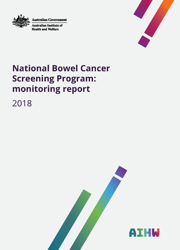Summary
In 2018, it is estimated that about 17,000 people will be diagnosed with bowel cancer and 4,100 people will die from bowel cancer.
The National Bowel Cancer Screening Program (NBCSP) began in 2006. It aims to reduce the morbidity and mortality from bowel cancer by actively recruiting and screening the eligible target population aged 50–74 for early detection or prevention of the disease. This monitoring report is the third to look at the NBCSP using key performance indicators.
Participation
Of the 3.2 million people invited between January 2015 and December 2016,
41% participated in the program. This national participation rate was slightly higher than that for the previous rolling 2-year period (2014–2015) (39%). The recurring participation rate for people who had taken part in an earlier round and were receiving a subsequent screening invitation was 77%.
Screening results
In 2016, about 59,000 Australians returned a positive screening test, or 8% of those who were screened. Of those who received a positive screening test, 68% had reported a follow-up diagnostic assessment.
The median time from positive screening test result to diagnostic assessment was 54 days.
Cancers and adenomas detected
Data for cancer and adenoma diagnoses were not complete enough for formal reporting of that performance indicator. But, of the data available for participants who had a diagnostic assessment in 2016, 1 in 26 were diagnosed with a confirmed cancer (228) or a suspected cancer (1,182), and a further 4,439 participants were diagnosed with adenomas
(1 in 9 participants assessed). Adenomas are benign growths that have the potential to become cancerous; their removal lowers the risk of future bowel cancers.
Population groups
Participants who identified as being of Aboriginal or Torres Strait Islander origin, those who lived in Very remote areas, and those who lived in low socioeconomic areas all had higher rates of positive screens, but had lower rates of follow-up diagnostic assessment, and a longer median time between a positive screen and assessment.
Since the NBCSP began
Since the program began in August 2006, about 4.4 million NBCSP screening tests have been completed, with about 234,000 participants having a diagnostic assessment to follow up a positive screening result.
From the data available for participants who have had diagnostic assessment, 1 in 30 have been diagnosed with a confirmed or suspected cancer, and 1 in 7 have had an adenoma detected. A previous study by the Australian Institute of Health and Welfare (AIHW) found that the NBCSP is helping to reduce morbidity and mortality from bowel cancer in Australia (AIHW 2014a).



